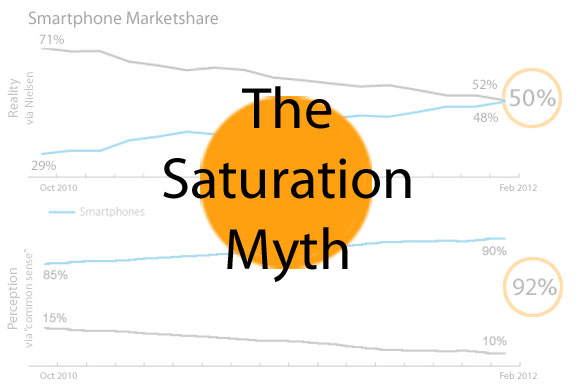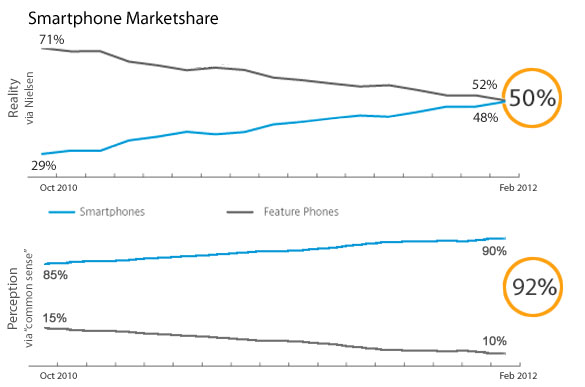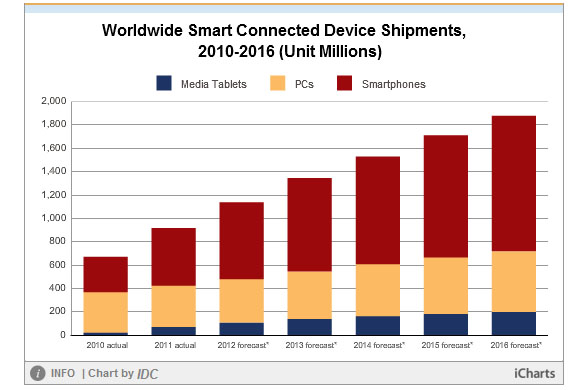The myth of the saturated smartphone market
Ever since the days of the original Palm Pre, worries about saturated market has permeated many reviews and reports about new entrants in the smartphone ‘race’. A lot of the tech press were raising flags, suggesting Palm was in a “too little, too late” position.
Palm was certainly in the “too little” category, I’d argue they were far from “too late”. There were a lot of problems with Palm’s WebOS reboot, few of which had to do with timing. Unfortunately, because Palm (via HP) did crash and burn, it reinforces the idea that “market saturation” is the problem when it comes to both Windows Phone’s adoption rate and RIM’s hopes with Blackberry 10 to reverse its downward trend.
All attention is on the current front runners. “There’s just no more room for a third ecosystem to grow, and lets just watch Apple and Google fight it out, and everyone else should just pack it in now” is the overwhelming vibe that everything from small blogs to online editions of major newspapers tend to propagate. The only problem is, the idea that the smartphone market is saturated is a myth, which brings me to this quote:
“You are not entitled to your opinion. You are entitled to your informed opinion. No one is entitled to be ignorant.”
– Harlan Ellison
Since before starting up rgbFilter.com in 2008, most analysts have been saying that the smartphone market will hit saturation in sometime 2015 in the US, which is a good barometer for us here in Canada as well, given our similar adoption patterns so far. Market saturation for most products means when roughly 95% of the market potential has adopted them. In some countries, especially in Western Europe where a lot of cross border travel occurs, there is more than one mobile phone per person, though these aren’t all smartphones. Some other parts of the world won’t see saturation for many years.
For example, the latest numbers from Nielsen show that the US smartphone market just hit 50% saturation in February, with about 2/3 of new customers choosing smartphones. Similar numbers that quash the myth also released in the past month are the latest projections from IDC are suggesting that worldwide smartphone shipments will more than double between 2011 numbers and 2016.
In short, the smartphone market is far from saturated. Why does the myth continue then?
“We don’t see things as they are, we see them as we are.”
– Anais Nin
The above has long been amongst my favourite quotes. It’s both elegant and all encompassing, while conveying a certain introspection and being open to multiple interpretations. My personal interpretation of it is as a mantra, to attempt to look at things beyond my own pre-conceived notions. How does Anais Nin’s quote apply to the common myth of market saturation?
It’s the perception of saturation. From my personal experience, most people I know are using smartphones of one type or another. If I were to use my circle of friends and family as a barometer, the market would be over 90% saturated. But that’s from my limited experiental knowledge. Experiential knowledge is crucial, but at the same time, personal experiences by their nature often cloud objectivity, even in the light of cold hard facts.
We as humans tend to gravitate towards like-minded individuals. As we do, we’re influenced by each other, and often encorporate mannerisms and phrasologies from each other. In some cases, we develop communication short hand to the point where an outsider would be lost to what we were saying, even though we speak the same language. It’s a part of the subconscious nature of experiental knowledge.
The same linguistic shorthand applies to the online world as well, and this applies to the market saturation myth. The myth has been around for a few years now and has never been questioned by any of the major tech press, instead repeating what they’ve read elsewhere, building their own unassailable reality. Barring a dramatic shift in the market, even the US is about 2 years away from market saturation. All the historical data, tracked for years now, points to this… and has been covered by the very same tech sites that still propagate the “we’ve hit market saturation” myth in every opinion piece and review.
I can’t help but see some irony in that.







402196 966036A persons Are normally Weight loss is certainly a practical and flexible an eating plan method manufactured for people who suffer that want to weight loss and therefore ultimately conserve a significantly much more culture. weight loss 125383
104199 592637Wow! This can be one certain with the most useful blogs We have ever arrive across on this topic. Really Excellent. Im also an expert in this subject so I can realize your hard work. 448699